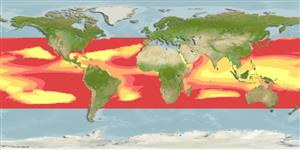>
Syngnathiformes (Pipefishes and seahorses) >
Centriscidae (Snipefishes and shrimpfishes) > Macroramphosinae
Etymology: Macroramphosus: Greek, makros = great + Greek, rhamphos = beak, bill (Ref. 45335).
More on author: Lowe.
Environment: milieu / climate zone / depth range / distribution range
Ökologie
seewasser; tiefenbereich 50 - 500 m (Ref. 58302), usually 50 - 150 m (Ref. 58302). Deep-water; 45°N - 40°S, 180°W - 180°E
Indo-Pacific and Western Central Atlantic: Indo-West-Pacific: Africa through the tropical Pacific to Hawaii and Desventuradas Is. and Juan Fernandez Is. (Ref. 89357). Eastern Central Pacific: California, USA. Western Central Atlantic: Florida, USA and Bahamas to Cuba (Ref. 7251).
Size / Gewicht / Alter
Maturity: Lm ? range ? - ? cm
Max length : 15.0 cm TL Männchen/unbestimmt; (Ref. 2850)
Kurzbeschreibung
Morphologie | Morphometrie
Rückenflossenstacheln (insgesamt): 4 - 7; Rückenflossenweichstrahlen (insgesamt): 10-13; Afterflossenstacheln 0; Afterflossenweichstrahlen: 18 - 19; Wirbelzahl: 23 - 24. Branchiostegal rays: 4 (Ref. 36710).
Found in a wide range of habitats, from near surface to near bottom and sometimes in huge schools (Ref. 2850). May range into coastal waters (Ref. 36711). Oviparous, with planktonic eggs and larvae (Ref. 36711). Seems to be sympatric with Macroramphosus scolopax (Linnaeus, 1758) all around the world (Ref. 89357).
Life cycle and mating behavior
Geschlechtsreife | Fortpflanzung | Ablaichen | Eier | Fecundity | Larven
Robins, C.R. and G.C. Ray, 1986. A field guide to Atlantic coast fishes of North America. Houghton Mifflin Company, Boston, U.S.A. 354 p. (Ref. 7251)
IUCN Rote Liste Status (Ref. 130435)
Bedrohung für Menschen
Harmless
Nutzung durch Menschen
Mehr Information
ReferenzenAquakulturAquakultur ProfilZuchtlinienGenetikElectrophoresesVererbbarkeitKrankheitenVerarbeitungNutrientsMass conversion
Tools
Zusatzinformationen
Download XML
Internet Quellen
Estimates based on models
Preferred temperature (Ref.
123201): 11.8 - 26.8, mean 19.7 °C (based on 1175 cells).
Phylogenetic diversity index (Ref.
82804): PD
50 = 0.7502 [Uniqueness, from 0.5 = low to 2.0 = high].
Bayesian length-weight: a=0.01479 (0.00600 - 0.03648), b=2.93 (2.72 - 3.14), in cm total length, based on LWR estimates for this (Sub)family-body shape (Ref.
93245).
Trophic level (Ref.
69278): 3.4 ±0.5 se; based on size and trophs of closest relatives
Widerstandsfähigkeit (Ref.
120179): mittel, Verdopplung der Population dauert 1,4 - 4,4 Jahre. (K=0.55-1.18; tmax=2).
Fishing Vulnerability (Ref.
59153): Low vulnerability (12 of 100).
